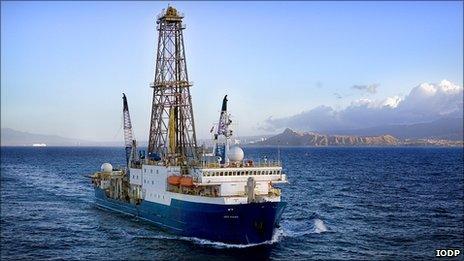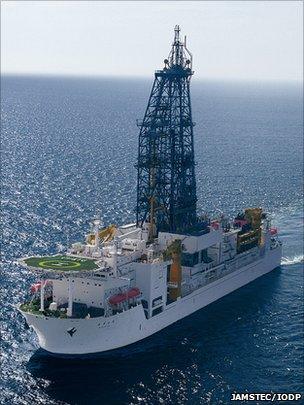Funding cuts leave science programme all at sea
- Published
- comments

The Joides Resolution ship was originally an oil exploration vessel
In these cash-strapped times, it's no surprise to see funding disappearing from science and environment projects - even those that have huge potential to alleviate hazards felt by many millions of people around the world.
The latest likely casualty is one of the most enticing of all earth science collaborations - the Integrated Ocean Drilling Program (IODP), external.
Bringing together the best scientists available, with funding supplied principally by Japan, the US and Europe, its remit is to facilitate research that involves drilling into the ocean floor, with a range of aims.
Basic geology, past climate change, earthquake prediction, volcanoes, and life beneath the seabed are all in its portfolio.
A few years ago, I spent four days on board the newest and most high-tech ship available, the Chikyu, external, as engineers drilled into the Nankai Trough, a serially and lethally seismogenic zone off the Japanese coast.
The long-term aim of this NanTroSEIZE project, external is to place sensors in bore-holes right down in the zone where the massive quakes begin, a three-dimensional sensing array made four-dimensional by the fact that data would stream back in real time as the rocks churn in preparation for rupture.
If any project in the world is going to answer questions about earthquakes of the type that devastated northern Japan earlier this year, or Chile last year, or so many shorelines in 2004 - it is probably this one.
Other projects recently announced in the next 10-year IODP science plan, external, to run from 2013, include drilling into the giant Chixulub impact crater whose creation appears to have brought the end of the dinosaurs, clarification of ancient climate change signals in many locations that could help understand present-day warming more precisely, and a bid to take the first samples ever from the Earth's mantle.
However, a massive question mark now looms over how much of this is going to happen.
Cuts ahead
Last week the US National Science Foundation (NSF) announced, external it would no longer run its own research ship, the Joides Resolution, external, in the guise of a "joint lead agency" within IOPD, but as an independent venture.
"This new funding environment has necessitated a re-evaluation of program priorities and options for the future of scientific ocean drilling," its statement reads.
Although the statement is couched in the kind of obfuscatory language to which big organisations always seem to resort when cuts are on the cards, and although further discussions are happening, the potential import is clear:
"The new approach does not guarantee that NSF will continue to support scientific ocean drilling in the future..."
This kind of research is hugely expensive, with the Chikyu costing in the order of $200,000 per day to operate - and already, both ships are hired out to commercial operators for about half of each year in order to gain some revenue.
The money goes down two distinct pathways - core support for the ships, sailing crews and so on, and budgets to fund the various science cruises and specialists on board.
Peering through the fog of NSF's jargon, it appears to be hoping that by concentrating dwindling funds on the Joides Resolution itself, it can ensure the ship continues to operate.
As to money to do science: "NSF will independently solicit contributions from international partners for support of JR operations".
In the current financial climate, one might say: "good luck with that".
What it all means for the welter of science cruises planned for 2013-2023 is currently anyone's guess, although the timing - just months after the 10-year plan was announced - resembles a divorce shortly after leaving the altar.
Masa Kinoshita of the Institute for Frontier Research on Earth Evolution (IFREE), external, one of the leaders of the NanTroSEIZE project, suggested it could constrain the research.
"I am very much concerned, as well as many of my colleague researchers (not only in IFREE)," he told me from Tokyo.
"I am concerned about the pressure toward shortening NanTroSEIZE program, even if it does not reach the final target (7000m below sea floor)."
The fewer sensors are deployed in the project, the less data will be received - and the less likely NanTroSEIZE is to resolve the question of earthquake predictability.
There's also a fear, he said, of isolation - with Japanese researchers being forced to go it alone without the hugely valuable co-operation they have (in both directions) with peers from other countries.
Not all bad
Perhaps his own closest international collaborator is Harold Tobin from the University of Wisconsin-Madison, external.
He's more optimistic that something good can emerge from the NSF's review - perhaps a structure that can even lead to the ships spending more time on science than on commercial contracts. But he has concerns too.
"There's almost no question that our scientific imagination and goals are outstripping our funding realities - that's been chronic for a while," he told me.

Japan's Chikyu vessel is capable of carrying 10km of drilling pipes
"But I am somewhat concerned that in the current political and funding environment for science that we're going to compromise our ability to do the cutting edge marine science that the world needs - a very real concern that international marine science won't be able to step up and do everything we ought to be doing for the sake of the planet."
Added to which there must be a fear that further dollars will be lopped off the NSF budget if elements in the US Congress seeking to strip US funding from anything with the words "climate change" in it, external fully understand the climate dimension of Joides Resolution's work.
Perhaps the most exciting of all the IODP's projects, at least in the sense of pure knowledge pursuit, is the "mantle quest" - the bid to drill into the mantle rock that makes up most of the Earth's mass and volume, which has never yet been directly penetrated.
A vast Soviet project, the Kola Superdeep Borehole, external, tried to reach the join between the crust and mantle - the Mohorovicic Discontinuity, or Moho - but failed.
It should be easier at sea, because the crust is much thinner.
Because you'd have to drill a number of investigatory holes before embarking on the big one, both the Joides Resolution and Chikyu would be used, with perhaps a decade elapsing between initial entry and final attempt - making it a project from which the necessity of long-term, international collaboration leaps out.
Damon Teagle from the UK's Southampton University, external is one of the prominent scientists on the IODP mantle programme.
"We should take a deep breath and not panic," he told me.
"These decisions have to be taken when the global economy has been in recession for three years and oil prices are very high and research council budgets are flat - we're not talking about drilling the mantle hole for another decade and the situation might be completely different by then."
The key, he said, was to have the ships engaged on science rather than commercial ventures for more than half of each year. Less than that, he suggested, "effectively meant the end of scientific ocean drilling" as it would mean trying to engage key staff for just a fraction of each year when they would presumably want to be employed for much longer periods.
So you look around at the size of the budget deficits various nations are facing now - $13 trillion and counting, in the US case - and you think "ok, I get this decision".
But the cost of scuppering the IODP could be measured in the lives that won't be saved by understanding earthquakes and tsunamis well enough to predict them - or in the lack of insights we'll gain into how climate change can be amplified through feedback processes.